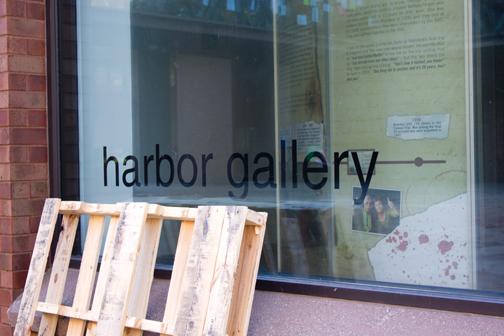Concealed by a freight elevator in a large-windowed space on the first floor of McCormack, the Harbor Art Gallery (HAG) does not always register in the minds of students. Funded by the Student Activities Trust Fund through the department of student activities since its creation, the gallery is a student-run space that has been an active part of UMB since 1979.
The goal of the gallery is to give students who are considering a professional career in museums or galleries an opportunity they may not otherwise have. The director does not have to be an art major, though adviser Donna Neal noted, “Traditionally, students who have been involved and have done the best job learning curatorial skills and how to run the gallery have, at least, been art minors.”
Occasionally, Neal says, UMB art students ask to be exhibited in the gallery, a request “not completely off base considering it’s an art gallery.” In that case, she said, they make sure there’s a slot available if the department wants to host their yearly capstone show.
Between the capstone and honors students who must both hold exhibitions, the requests for display space in the art department are numerous.
“It’s the first and only professional experience students get to have in organizing works from diverse media coming [together] in a cohesive, or semi-cohesive, way around a theme and preparing for the experience of getting work out to the public,” Wilfredo Chiesa, professor of art, said.
Part of the difficulty is that gallery space is booked a year in advance, with the HAG being no different. Neal said that they try to plan a minimum of a semester in advance. Hart believes students are unaware of the citywide lack of spaces dedicated to student work. She encourages the use of what is available first.
“I think that’s the first thing they think of when they want to do a show on campus, as it does have some visibility,” Hart said. “The first place we ask them to check [is the HAG] and to meet with the director. It’s a convenient space; it’s UMass Boston-affiliated space. If they’re an art student, it showcases the art student to the rest of the university community. I love having the gallery here; it’s a great asset. It would be nice to have more of that cultural presence on campus.”
It’s about as harmonious of a relationship can be expected on a university campus. “It’s as good as it can be,” Neal said, “especially when dealing with student [directors] who can differ in opinion from faculty at times. Students are here to learn and grow and sometimes there are differences. It’s all in the learning process.”
The art department itself has never controlled a space on campus, although there are plans for a department-controlled gallery in the new building to be constructed in 2014. Hart hopes that there will also be space for a professional gallery with a curator to use as an educational experience, but the space secured in the projected building is specifically for student use.
“I would hope that, as the campus moves forward with its 25-year plan that we continue to build cultural venues,” Hart said. “The new student space is great. Having the Harbor Art Gallery be visible and right here is great. Having a professional gallery could bring in another layer of what the visual arts are, including not just traditional arts but new media. Building the cultural economy on this campus could benefit the whole campus tremendously.”
The Harbor Art Gallery has fostered collaboration among other departments as well. In the spring 2011 semester, an artist with politically-focused work was brought in from Mexico at the suggestion of a professor in the sociology department and encouraged members of the political science department to bring in some of their students.
These kinds of collaborations are not only encouraged, but sought out by Neal. She actively contacts departments to see if any faculty members are teaching a course on a topic related to an upcoming exhibit and extend and opportunity to host their class in the gallery.
“Sometimes that’s the only way people find out there’s a gallery, particularly now that the Campus Center is open,” Neal said.
“I think it’s beneficial to have this space,” Alyssa Kelley, a junior psychology and sociology major, said. “It showcases people’s work and gives diversity to the campus. It shows we’re not all academic and gives people [a chance] to showcase what they’re doing. I remember seeing a graffiti exhibit through the McCormack window and thinking how cool it was, because I could never do that.”





















































